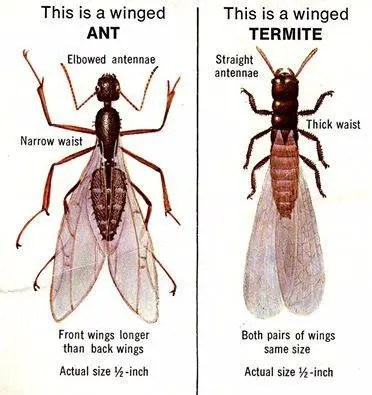Swarming Termites vs Flying Ants: What’s the Difference?
As homeowners, one of the challenges we often face is distinguishing between different types of pests that invade our homes. Particularly perplexing is the difference between swarming termites and flying ants. Both can be seen in and around homes, often causing alarm and confusion. Understanding the key differences between these two is not only crucial for proper pest identification but also for implementing the right control measures. In this comprehensive guide, we will explore the distinct characteristics of termites and flying ants, helping you to identify them accurately.
Identifying Swarming Termites vs Flying Ants
 Swarming Termites
Swarming Termites
Termites, particularly swarming termites, are often mistaken for flying ants. Swarming termites are reproductive members of the termite colony, characterized by their straight antennae, thick waists, and wings of equal size. Their swarming is typically triggered by warm temperatures and rain from early spring to summer (2024), signaling the start of the termite mating season.
Flying Ants
Flying ants, in contrast, are the reproductive members of ant colonies. They can be identified by their elbowed antennae, constricted narrow waists, and wings of unequal length. Unlike termites, flying ants are more commonly seen during dry weather.
Behavior and Habitat
Termites
Termites feed on cellulose, primarily found in wood, making homes a prime target for these pests. They are capable of causing significant structural damage silently and can go unnoticed for long periods.
Ants
Ants, while a nuisance, generally do not cause structural damage. They are scavengers and predators and are attracted to sweet substances and other insects. (exception: Carpenter Ants)
Signs of Termite or Ant Infestations
Detecting the presence of swarming termites or flying ants early is key to preventing extensive damage.
Termites
Signs of termite infestation include discarded wings, mud tubes, and damaged wood. Termites tend to eat wood from the inside out, so wood that sounds hollow when tapped can be a warning sign.
Flying Ants
Flying ants don’t typically damage homes but can be identified by their presence in large numbers, especially near sources of food or moisture.
Prevention and Control
Effective pest control starts with prevention. Regular inspections and maintenance can deter both termites and flying ants.
Termites
For termites, it’s crucial to reduce moisture around the foundation of your home, store firewood away from the house, and seal any cracks or crevices.
Ants
To prevent ants infestation, keep your kitchen clean, seal food containers, and manage waste properly. Eliminating standing water and sealing entry points can also be effective.
In summary, while swarming termites and flying ants may seem similar, understanding their differences is vital for homeowners. Whether it’s the structure-damaging swarming termites or the less harmful flying ants, early identification and intervention are key to protecting your property. If you’re unsure or concerned about potential infestations in your home, it’s wise to consult professionals. D & D Pest Control Co. offers expert inspection services to identify and address any active termite problems. Don’t let termites or flying ants take over your home; contact D & D Pest Control Co. for a thorough inspection and peace of mind.
 Swarming Termites
Swarming Termites
